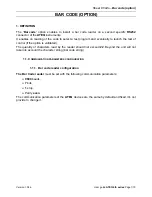
50
Operation
Theory
start_line_tr_move(2, Axis, Dist, 10.0, 50.0,
15.0, 0.3, 0.2)
This cause the two axes (axes 0 & 2) to perform a linear interpola-
tion movement, in which:
Δ
X = 30 mm
Δ
Y = 40 mm
Start vector speed=10mm/sec, X speed=6mm/sec, Y
speed = 8mm/sec
Max. vector speed=50mm/sec, X speed=30mm/sec,Y
speed=40mm/sec
Final vector speed=15mm/sec, X speed=9mm/sec, Y
speed =12mm/sec
Acceleration time = 0.3 sec
Deceleration time = 0.2 sec
Figure 4-6: 2-Axis Linear Interpolation Example
3-Axis Linear Interpolation
Any 3 of the 12 axes of SSCNET board may perform 3 axes linear
interpolation. As the figure below, 3 axes linear interpolation
means to move the XYZ (if axes 0, 1, 2 are selected and assigned
to be X, Y, Z respectively) position from P0 to P1 and start and
stop simultaneously. The path is a straight line in space.
Summary of Contents for PCI-8366+
Page 4: ......
Page 14: ...x List of Figures ...
Page 17: ...Introduction 3 Figure 1 3 Flowchart for Building an Application ...
Page 26: ...12 Installation 2 2 PCI 8372 8366 Outline Drawing Figure 2 1 PCI 8372 8366 Mechanical Drawing ...
Page 31: ...Installation 17 2 Press HPI boot ...
Page 32: ...18 Installation 3 Press Flash DL button and select a kernel4 hex ...
Page 34: ...20 Installation Figure 2 3 SSCNET Communication Test Utility ...
Page 49: ...Signal Connections 35 Figure 3 9 Skin Type ...
Page 144: ...130 Operation Theory ...
Page 149: ...Motion Creator 135 Figure 5 6 Software Version Information ...
Page 160: ...146 Motion Creator Figure 5 13 Channel Selection Frame Figure 5 14 Motion Frame ...















































